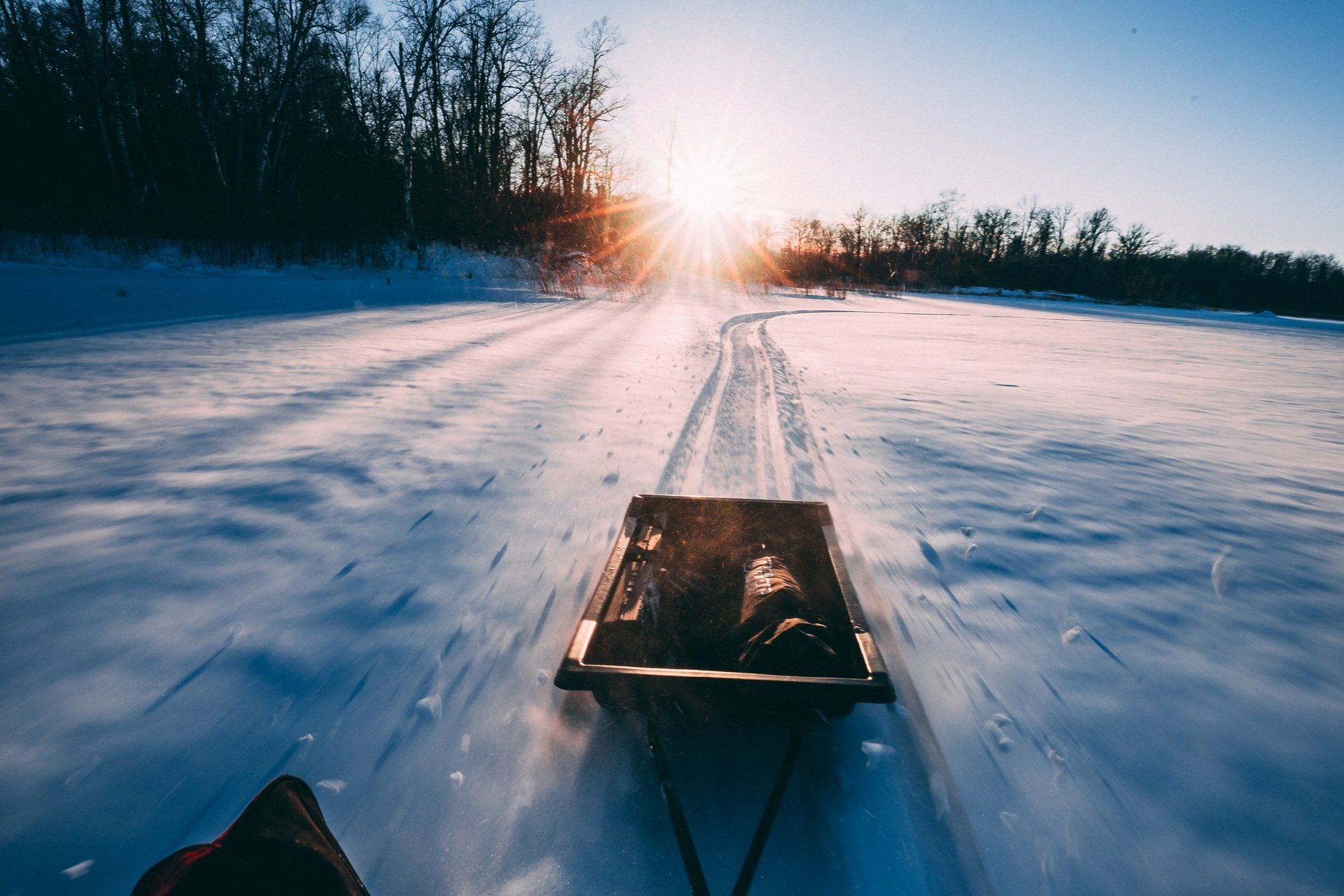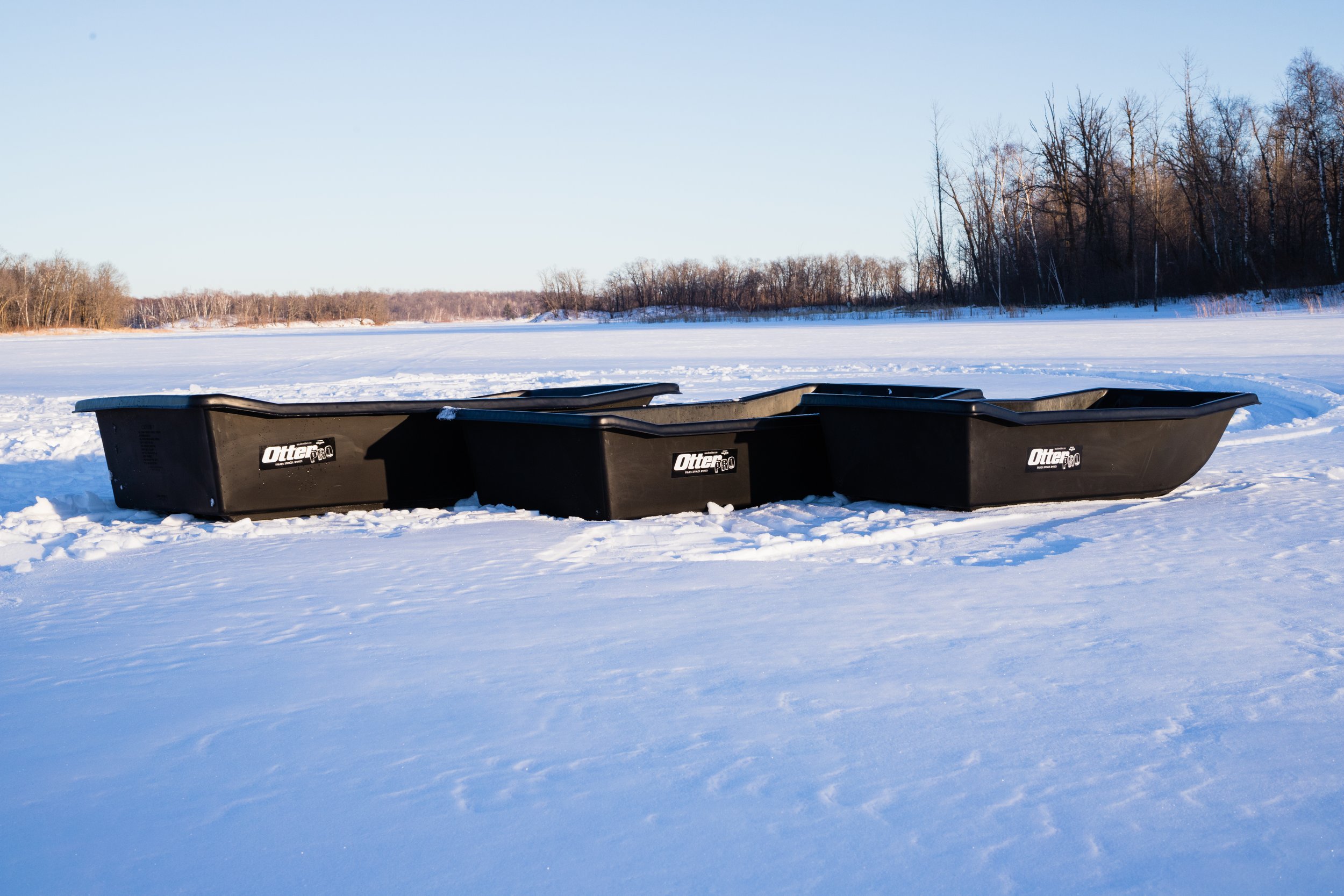Which Otter Sled to Buy? Pro Sled or Sport Sled?
If you’ve done your homework, you already know that Otter Outdoors makes the best sleds on the market. But did you know there are differences between the sleds that Otter offers? They’re both roto-molded, which makes for the sturdiest, longest-lasting sleds on the market. It’s a real feather-in-the-cap for any manufacturer to utilize roto-molding in designing durable outdoors equipment, given the lengthy successful track record in a host of products of the years. That said, in terms of sleds, beyond roto-molding, the Pro Sled vs. Sport Sled features diverge from there.
Why Roto-Mold?
Rotational molding of sleds is a pretty simple process, where a hollow mold is filled with a powdered or pelletized plastic resin. The mold is rotated upon its axis in multiple directions while heat is applied, melting the interior plastic and coating the walls of the mold uniformly. The mold is cooled, rotation is stopped, and the sled is popped out of its form for later use.
While the process is straightforward, the results are superior in design from that of other sleds. Unlike competitive processes, roto-molding produces no pinch-off seams or weld-lines, resulting in a fully-finished final product. That’s why, no matter the industry or application, roto-molding is the construction method of choice for products that require high-quality finishes, uniform wall thickness, high stability, and long-life durability.
To further understand why roto-molding is the construction method of choice for sleds, it might be best to discuss “why-not.” The disadvantages of roto-molding are primarily born by the manufacturer, from the high cycle times it takes to rotate each sled, the higher cost of raw materials, and the increased labor costs needed to generate a single product, the negatives are a positive for the end consumer. You get a stronger sled that’s more stable and durable, with consistent thickness from front to back. That means the corners and traditional weak and wear-points on other sleds aren’t an achilles heel for roto-molded varieties. It’s a superior product that requires specialized construction.
Sled Uses
Likely, you’ve hand-town the red, kid’s plastic sleds with all of your gear and dumped it out several times on the way to your spot. I know, because I’ve done the same over the years. Even when auger, shelter, and all your gear is strapped into these sleds, all it takes is a rut, small bump, or ice chunk to unsettle the load and strew it upon the ice. You’re here because that’s getting more than annoying.
Or perhaps you’re using the sled for more utility purposes. Hauling a deer out on ATV, pulling some cut firewood on the snowmobile, or dragging some landscaping rocks around the yard with your mower. I could go on and on with the list of things I’ve used an Otter sled for around the farm or around the yard. From backyard mulch to boulders, the sheer number of utility applications for a sled are incredible.
Yet, for each of these use-cases, the rigors of the terrain and conditions may cause for separate sleds. Regretfully, there is no one-size or one-type-fits-all approach to selecting a sled for your needs. There’s just too much variability in use, and too many features that each the Pro Sled and the Sport Sled possess which make them less interchangeable than you might think. Which is a good thing. Just like you don’t use your screwdriver for a punch or a wrench for a hammer, the right tool for the job is important for any outdoors-person.
Luckily there’s a few good ways to determine the right sled for each approach, and the first jumping off point, is determining what method of transport you’re using. Simply put, if you’re hand-towing, you’re in need of a Sport Sled, and if you’re towing by machine, you want a Pro Sled. It gets a bit more complicated from there, but that’s the major fork in the road.
Sport Sled
The Otter Sport Sled is an interesting case. Meant to compete-with, but outperform cheaper sleds in its class, it’s a sleigh that works perfectly in deep snow years and other times when you want to save weight and hand-tow out onto the lake. It’s made with only slightly less material, resulting in a sled that saves nearly half the weight of the Pro-Sled in a similar size. That weight savings is a primary advantage for anyone looking to ease a hand-drag of any distance.
Yet, what it shaves in weight is not skimped upon in other areas. The Sport Sled still features high sides to corral gear into place for uneven treks. It also maintains a high raised back-wall for security of gear, giving longer and shorter items in the sled something to brace upon when going up an incline. There’s a tow rope included, which can be extended with a rope of your choice for longer drags. Surprisingly, the side-wall stability of the Sport Sled could be the best feature of the product. Otter managed to cut weight on the overall product without sacrificing how substantial it feels or the overall stability of the sled itself.
If you’re hand-dragging, this is the premium sled in its category. The angle of attack on the front of the sled climbs over uneven ice or boulders at the landing, then maintains and even and easy pull when out on the flat stuff. Small ridges collect meltwater inside the sled to keep your gear dryer, but also serve as rails when pulling on sheer ice or snow, providing some directionality to the pull while improving the experience to the person putting in the effort. The raised and rolled-over edges accept a variety of bungie cords or ratcheting straps, and the material is tough enough to drill into, giving you options to customize how you strap, tow, or otherwise trick out your sled.
Pro Sled
The Otter Pro-Sled is the original big brother to the Sport sled in every way. Picking up and setting down the two of them side by side gives you an understanding of how substantial and durable the Pro Sled really is. It is heavier, nearly twice as heavy as the Sport Sled, but it’s supposed to be. The extra custom compounded polyethylene material is appreciated whenever machine towing is the order of the day. Whether you pull with an ATV or snowmobile over the open ice, or simply tow around the yard with your lawn-mower, the Pro Sled is the strongest, most durable sled available on the market, period.
That durability starts with more than just extra material, but extends to where and how it’s utilized. A raised front is perfect for attacking snow but preventing it from getting into the sled, and the raised rear provides extra room for gear to brace against and remain in the sled on faster tows across long distances. A reinforced outer lip provides additional stability to the entire sled, preventing excess flex or twisting of the sled again when towed at greater speeds.
A standard 5/16” bottom means that wear is less of an issue when towing, ensuring minimum overall degradation of the part of the sled that comes in contact with snow or earth. Typically however, it’s recommended to install hyfax (think wear bars) rails that are bolted on to the bottom of the sled. Not only do they improve tracking in snow, they extend wear to the hyfax and protect the investment you made in your Pro Sled.
Because of the increased thickness and durability of the sled, Otter has roto-molded hitch pockets built-in to the front of the sled. That means no drilling into the front of the sled to secure a tow hitch, and no jeopardizing the strength of the sled by reducing the load to two small points of contact between tow vehicle and Pro-Sled. These are points of contact that have never failed under normal use, and represent the single best way to connect a tow-vehicle to a sled. The Otter tow-hitches are connected via two stainless steel pins that go through the roto-molded pockets, and connect back to the snowmobile or ATV. This rigid-hitch construction means the sled won’t slam into the back of your vehicle when you come to a stop, and improves the life of your sled and the gear it hauls.
Sizes and Accessories
Take careful note of the dimensions for each of the sleds you’re interested in. It’s recommended that you measure your transport vehicle space if you’re stashing the sled in a truck or on a trailer, such that the sled itself fits in whatever space you need it too. Also, take note that sizing isn’t the same between Pro and Sport sleds, meaning that a Medium Sport Sled does not have the same dimensions as a Medium Pro Sled. Again, a tape measure is your best friend when selecting the correct and proper sizing for your application.
Both sleds can be improved upon, if ever so slightly, by the addition of a few accessories. For the Sport Sled, a cover that matches each size can really be much more effective than basic straps. Not to mention, if snowing or pulling through deep snow, it keeps the interior of the sled and your gear dry. While you can attach a universal tow hitch to the Sport Sled, as you’ve read, towing by machine is done much more effectively with the Pro Sled.
The Pro-Sled also has its own travel cover options, as well as more options to extend its use related to towing. We mentioned the tow hitch, but there’s also the additional hitch pins for each end of it that simply fit perfectly to the sled and its hitching points. There’s also the rear sled hitch receiver, which allows you to “daisy-chain” and tow multiple sleds end to end from the same tow-vehicle. It’s a nice feature when you want to haul additional gear for specialized uses. Hyfax is available as mentioned, but so is a really slick product called the hitch pivot. It installs between the sled and the tow hitch, and allows you to fold your hitch over the top of your pro-sled and cover when transporting on truck or trailer. It’s a real time-saver as you no longer have to pull pins in the snow and cold up tight and underneath the sled.
Final Bits
It’s useful to have a Pro Sled and Sport Sled both for the very different use-cases they each present, yet if you had to choose only one, think about the original question of hand-tow vs. machine-tow. On top of it, consider how rugged you need it to be, as you shouldn’t expect a sport sled to perform the way a pro-sled would under extreme conditions or uses. In either case, it’s a reasonable expectation that these sleds will last you decades. Often, that’s much longer than the rest of your ice or outdoors equipment, so it’s an investment you make that reaps dividends over the long-haul. That makes either the Pro-Sled or the Sport-Sled a great piece of outdoors gear that you can count on for years to come.




